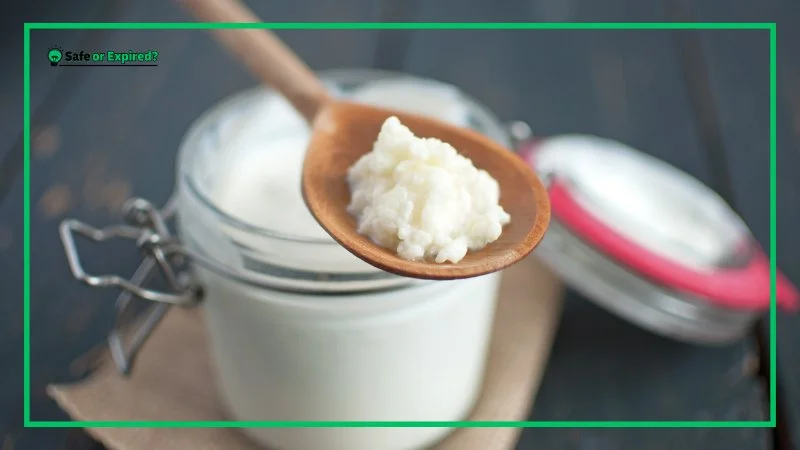Have you ever wondered, “Does kefir expire?” Unfortunately, like all dairy products, kefir has a shelf life that we should respect to enjoy its benefits safely.
In this guide, I’ll dive into how to store kefir correctly, signs that your kefir has gone bad, and whether expired kefir makes you sick. So, keep reading.
Does Kefir Expire? Complete Details
Yes, kefir does expire. Kefir’s longevity is significantly influenced by how it is stored. When kept in the fridge, kefir remains fresh and safe to consume up to a certain point past its expiration date. Note that offering a cool environment that slows the fermentation process and prevents spoilage.
But Does kefir expire in the fridge, too? Yes. At some point, it will go bad in the fridge as well. Now, let’s discuss the question, “Does kefir go bad if left out?” If left out at room temperature for more than a few hours, especially in warm conditions, kefir can quickly go bad.
According to a study, the active bacteria and yeast continue fermenting, which can lead to over-fermentation, making it unpleasant to taste and potentially unsafe to drink. Always store kefir in the fridge and tightly seal it after each use to maintain its quality and safety.
How Long Does Kefir Expire? (The Final Date)
Kefir generally expires 2-3 weeks past its printed expiration date if it is unopened and placed properly in the fridge. Once opened, its lifespan decreases. Furthermore, whether you put it in the fridge or not also decides the shelf life.
You may now be wondering, how long does kefir last in the fridge once opened? It remains good for about a week, assuming it’s stored at a consistent and cool temperature.
For specific brands, such as Lifeway, how long does Lifeway kefir last after opening? Lifeway Kefir suggests consuming it within seven to ten days after opening to ensure the best taste and nutritional benefits, provided it’s kept refrigerated and sealed tightly between uses. Proper storage is key to maximizing kefir’s shelf life and maintaining its health benefits.
In discussing how long kefir lasts, it’s worth looking at other drinks too. Whether you’re into workout supplements or gaming energy drinks, knowing how to store them correctly is crucial.
Curious about Prime Drinks? They’re popular for a boost during workouts. Find out how to keep them fresh longer with our guide “Do Prime Drinks Expire? (Answer and 6 Key Storage Tips).”
How To Tell if Kefir Is Bad? (Main Signs)
To tell if kefir is bad, look for mold, an unpleasant smell, or changes in texture. Fresh kefir should be creamy without off-putting odors. If it’s lumpy, smells sour or foul, or shows signs of mold, it’s spoiled and should not be consumed. Always check before drinking.
Appearance Changes
Kefir’s natural appearance should be smooth with a slightly creamy color. Over time, however, introducing air and bacteria from the environment can lead to mold growth. This mold may present spots or patches on the surface of the kefir in various colors, including blue, green, or black.
Here’s what a good-quality Kefir looks like:

Any visible mold means the kefir is contaminated and should not be consumed. Additionally, a significant color change, such as a yellowish or pink tint, suggests bacterial growth that could be harmful.
Texture Alterations
Fresh kefir has a consistency that is notably thick and somewhat viscous, akin to a drinkable yogurt. It’s normal for kefir to separate into thicker curds and whey (a thinner, liquid part); this separation can often be reversed with a gentle shake.
However, if the kefir shows signs of excessive lumpiness, has developed a gelatinous texture, or appears curdled beyond normal separation, it indicates over-fermentation or contamination. Such texture changes suggest the kefir’s microbial balance is off, making it unsafe for consumption.
Off-Putting Smell
Kefir naturally possesses a sour or tart aroma due to its fermentation process, which is generally pleasant or at least not off-putting. This scent comes from the lactic acid produced by beneficial bacteria. If your kefir emits a smell that is strong, foul, or reminiscent of spoiled milk, it clearly has gone bad.
An off smell is a direct indicator that the fermentation has progressed to spoilage or unwanted bacteria have colonized the kefir, producing compounds that are not safe or pleasant to consume.
Taste Test
If the kefir passes the visual and olfactory tests but you’re still unsure about the quality, then do the taste test. Spoiled kefir will taste overly sour, bitter, or just unpleasant, significantly deviating from its expected tangy yet palatable flavor profile. It’s important to spit it out immediately if the taste is off, as consuming spoiled kefir can lead to digestive discomfort or foodborne illness.
Expiration Date
Manufacturers provide the expiration date on kefir as a guide to when the product is expected to remain at its peak quality under proper storage conditions. While kefir can sometimes be safe to consume slightly past this date, it’s essential to assess its condition using the abovementioned signs. A significantly surpassed expiration date increases the likelihood of spoilage, and such products should be cautiously approached.
And if you’re a fan of GFUEL for those long gaming sessions, make sure you’re using it at its best. Avoid common mistakes by checking out “Does GFUEL Expire or Not? Don’t Make This Mistake!”
Can Bad Kefir Make You Sick? Key Details
Yes, consuming bad kefir can indeed make you sick. Like any fermented dairy product, Kefir can harbor harmful bacteria or molds when it has gone bad, leading to foodborne illnesses if consumed. Here’s how spoiled kefir can impact your health:
Presence of Harmful Microorganisms
While kefir is praised for its beneficial bacteria and yeasts, once spoiled, it can become a breeding ground for harmful bacteria. Popular ones are E. coli and Listeria. These pathogens can lead to gastrointestinal distress and more severe health issues, especially in individuals with weakened immune systems.
Symptoms of Food Poisoning
Symptoms resulting from consuming spoiled kefir may include nausea, vomiting, diarrhea, abdominal cramps, fever, and dehydration. These symptoms can appear within a few hours to a couple of days after consumption and vary in severity based on the individual’s health and the amount of contaminated kefir consumed.
Increased Risk for Vulnerable Populations
Certain populations, such as young children, pregnant women, the elderly, and those with compromised immune systems, are more susceptible to the adverse effects of spoiled food. Consuming spoiled kefir can pose a significant health risk to these groups, potentially leading to more serious complications.
Mold Toxicity
If kefir has visible mold, it’s not just the moldy part that’s a concern. Some molds produce mycotoxins. What are they? Well, they are toxic substances that can lead to nausea, allergies, and more severe health issues if ingested.
Preventive Measures
To avoid the risks associated with bad kefir, always store kefir properly in the fridge, consume it by the expiration date, and heed the signs of spoilage before consuming. When in doubt, it’s safer to discard any kefir that might be spoiled rather than risk illness.
What to Do With Expired Kefir?
Expired kefir can be safely used for a variety of purposes other than drinking. You can incorporate it into baking recipes, use it as a marinade for meats, or add it to skincare routines as a natural exfoliant.
When kefir passes its expiration date, it often becomes too sour to drink but remains rich in beneficial bacteria and yeasts, making it useful in several other ways. In baking, the acidity of expired kefir can help activate baking soda, which makes for fluffier, softer baked goods.
As a marinade, the natural acidity tenderizes meat while adding a unique flavor. Additionally, the probiotic qualities of kefir make it excellent for skin care, particularly as a soothing face mask, helping to improve skin health by balancing its microbiome.
Conclusion
Understanding the shelf life of kefir is crucial for maximizing its health benefits while avoiding potential risks. Here’s a quick recap:
- Check for signs of spoilage: Mold, off-putting smells, and changes in texture are clear indicators that kefir has gone bad.
- Proper storage is essential: Store kefir in the fridge and consume it within one week of opening to ensure freshness.
- Beware of health risks: Consuming spoiled kefir can lead to foodborne illnesses, with symptoms like nausea, vomiting, and diarrhea.
- Visual and olfactory indicators: Always inspect and smell your kefir before consuming it to avoid ingesting harmful bacteria.
- When in doubt, throw it out: If you’re unsure about your kefir’s freshness, discard it rather than risk getting sick.
With this knowledge, you can confidently incorporate kefir into your diet, enjoying all the probiotic goodness it offers without worry.

